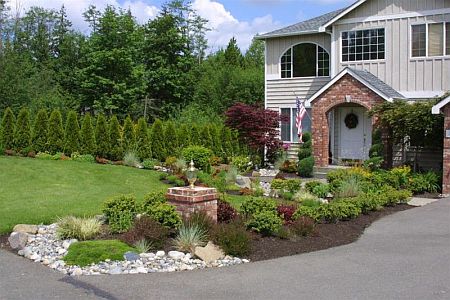Lawn Care For The Fall: Essential Tips to Follow

All summer you've been watering, cutting, trimming and feeding your yard in the hopes of having the greenest plot of land in the neighborhood. So what should you do to get your lawn in shape for the cool breezes of autumn? These six steps will help you get a head start on the colder weather.
Aeration and Overseeding
If you live in a climate with cool-season grass, fall is the perfect time to aerate your lawn because the air is cool and the soil is still warm from the heat of summer. The earlier you can do this, the better the results will be for your yard. Depending on where you live, September or early October is the best time to tackle this project. You'll pay around $120 for lawn aeration.
Aeration removes small plugs of soil from your lawn, allowing greater amounts of air, nutrients and water to reach the root system of your grass. It also reduces soil compaction in the process. Following aeration, you might want to overseed your yard. Overseeding makes it easier for seeds to germinate while the soil is loose.
Feed Your Yard
Fall is the prime season of the year to fertilize cool-season grasses. Unlike warm-season grasses, which often go dormant in the fall and winter, cool-season grasses can actually hit their peak growth rates during the fall. This means they need a full dosage of nitrogen to help boost the health of the soil and your grass. Most importantly, this will help prevent the growth of weeds, which choke out the grass over time.
Cut Down on Mowing
Throughout the summer, you've gotten into the habit of mowing weekly. But if you have cool-season grass, it's time to start cutting back on the number of mowing events each month. Generally speaking, every other week should be your maximum. If you have too much leaf coverage on your yard, you can mulch those up, but remember to leave your cutting deck high so you aren't cutting off too much of your grass in the process.
The professional recommendation is not to cut off more than one-third of the total blade of grass each time you mow. Doing so can result in scalping the lawn, which stunts the growth of your grass. If you live in a warmer climate with warm-season grass, you can likely skip mowing altogether because your grass is going into its dormancy cycle.

Leaf Removal
There are two approaches you can take when dealing with falling leaves. At a bare minimum, you should remove any fallen foliage within seven to 10 days because it blocks sunlight from reaching your grass. But, if you get a relatively light leaf fall each autumn and you own a strong mulching mower, you can turn fallen leaves into a composting gold mine. If you mulch your leaf fall on a regular basis -- at least once a week -- you are recycling the nutrients back into the soil. If your leaf pile is too big, consider hiring a pro. You can expect to pay about $310 for professional leaf removal services.
Sow and Reseed
Believe it or not, but fall is a great time to reseed the bare patches of your yard and sow new sections of lawn for cool-season grasses. Applying fresh soil and some new seed to barren patches of your yard can help prepare your lawn to bounce back in the fall. As mentioned earlier, this time of year is often the strongest for cool-season yard growth, so take advantage.
Winterize Your Sprinkler System
If you have an underground sprinkler system to help you keep your yard green all summer, it could be the biggest threat to your utility bill and soil during the winter months. If you fail to blow out your underground system, the water left in the pipes could freeze, expand and burst the pipes. This could lead to a water leak in your yard that could compromise the integrity of the soil and cause serious damage. If you live in a cooler climate, it's important to winterize your sprinkler system immediately.
Conclusion
With one weekend of work, you can accomplish most of these tasks and have a yard that looks great for the coming fall months.
Want to estimate your home improvement costs before talking with a contractor? Claim your home for free with bluehammer to estimate costs, secure your home inventory and learn more about your home.
* THIS REPORT IS AN OPINION THAT MAY BE INACCURATE AND IS PROVIDED SOLELY AS AN INFORMATIONAL TOOL NOT DESIGNED TO PROVIDE DEFINITIVE ANSWERS. ALL ELEMENTS ARE OFFERED "AS IS" AND BLUEBOOK EXPRESSLY DISCLAIM ANY AND ALL WARRANTIES, REPRESENTATIONS, AND GUARANTEES OF ANY NATURE, EXPRESS, IMPLIED OR OTHERWISE, INCLUDING BUT NOT LIMITED TO ANY IMPLIED WARRANTIES OF MERCHANTABLITILY, NONINFRINGEMENT, TITLE, QUIET ENJOYMENT, ACCURACY, OR FITNESS FOR A PARTICULAR PURPOSE. IN NO EVENT SHALL BLUEBOOK (OR THEIR SUPPLIERS) BE LIABLE FOR ANY GENERAL, DIRECT, SPECIAL, INCIDENTAL, INDIRECT OR CONSEQUENTIAL DAMAGES OF ANY KIND, OR ANY DAMAGES WHATSOEVER (INCLUDING WITHOUT LIMITATION, THOSE RESULTING FROM USE OF THE PRODUCT, INCLUDING : (1) RELIANCE ON THE MATERIALS PRESENTED, (2) COSTS OF REPLACEMENT GOODS, (3) LOSS OF USE, DATA OR PROFITS, (4) DELAYS OR BUSINESS INTERRUPTIONS, (5) AND ANY THEORY OF LIABILITY, ARISING OUT OF OR IN CONNECTION WITH THE USE OR PERFORMANCE OF INFORMATION) WHETHER OR NOT BLUEBOOK HAS BEEN ADVISED OF THE POSSIBILITY OF SUCH DAMAGES.